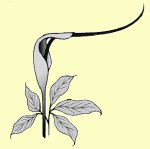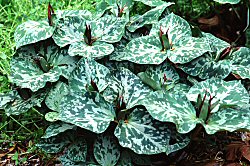
Arisaema dracontium
(green dragon, dragon root)
Home page
Articles
|

Awed by Trilliums
I garden because I'm constantly amazed by the
diversity of flower and foliage forms in the plant kingdom. Ex officio
board member Robin Bell's presentation at our March 19 meeting reminded me
that you don't need the whole kingdom to be awed. A single genus will do.
Bell took us on a visual road trip, retracing his travels last year from
Pennsylvania through the Blue Ridge Mountains to North Carolina, and later
on to New Zealand. While Robin focused on trilliums, he punctuated his
presentation with other spring ephemerals he encountered on the way.
In Pennsylvania, Robin saw wild woodland populations of trilliums in
nearly solid stands. "The range of variation is what excites me," he
noted. In one area, perhaps one flower in 50,000 was solid red, sticking
out like a sore thumb in a sea of white blooms. But the more subtle
effects of genes for red flowers were expressed here and there, with some
flowers speckled, dusted or bulls-eyed with reddish tones.
As Robin continued south, he observed even more variation in gardens and
in the wild:
Trilliums standing the full 18 inches or so most of us are familiar with.
Trilliums closely hugging the ground.
Trilliums holding their flowers high above the leaves or tight to the
foliage. Trilliums with their flower stalks tilted at odd angles.
Trilliums with modest blooms, as well as outspoken double-flowered
trilliums. Trilliums with spectacularly mottled foliage that you'd be
happy to grow even if they never flowered.
"I don't know why we don't grow them more," Robin wondered. "It wouldn't
be difficult at all to breed more garden-worthy varieties."
We need only look to New Zealand to see what the results might be. There
are no native trilliums there. But around 100 years ago, several of our
West Coast trilliums (most spectacularly, T. chloropetalum and
T. chloropetalum var. giganteum) were brought to the islands.
Over the last century, gardeners appear to have selected for different
flower colors and leaf variegation patterns, although no one really had a
solid understanding of their genetics. Most of the forms seen were not
named or propagated as individual plants, noted Robin.
While they remain nameless, the trilliums Robin saw thriving in the cool,
maritime climate of New Zealand's South Island sported an incredible
variety of foliage marbling patterns and flower colors, ranging through
reds and pinks to yellows and bronze. Hopefully such specimens will awe us
in our own woodland gardens sooner rather than later.
Craig Cramer
Web design and maintenance by Craig
Cramer, cdcramer@twcny.rr.com
|


